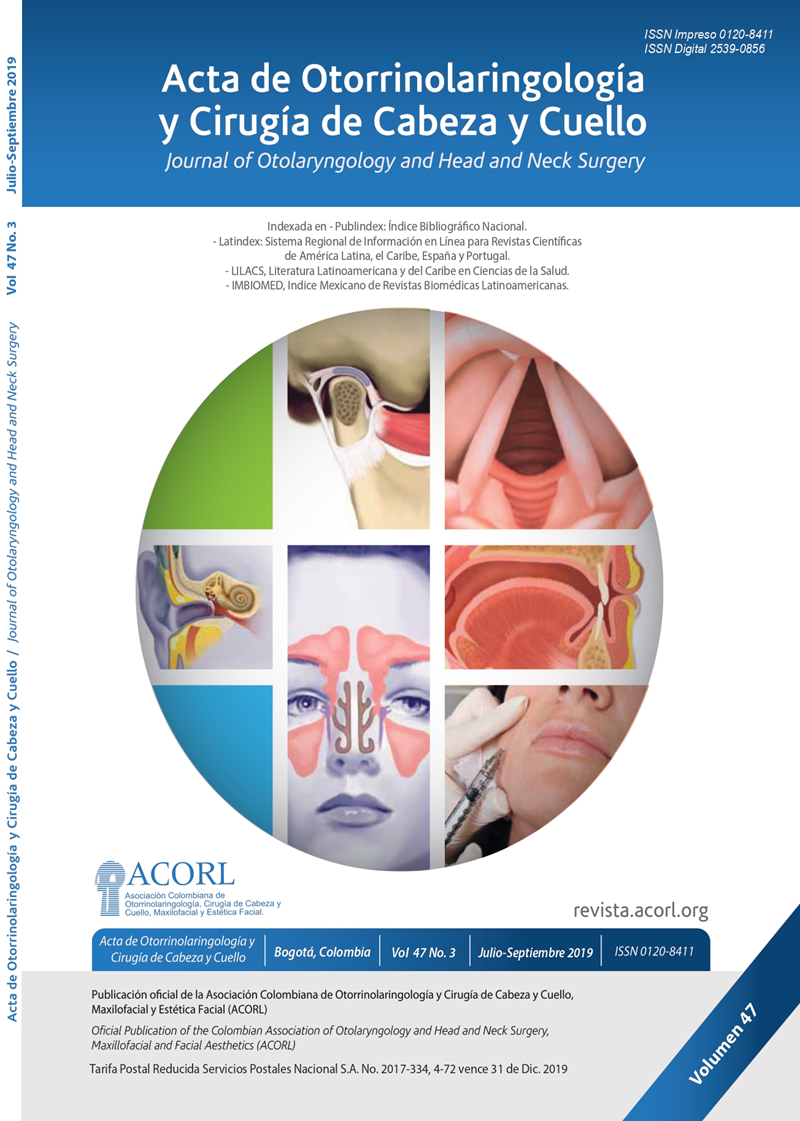Valoración ecográfica de la laringe fetal
Contenido principal del artículo
Resumen
RESUMEN
Objetivo: El diagnostico y tratamiento prenatal de múltiples enfermedades es posible en la actualidad, dado el conocimiento anatómico, el desarrollo tecnológico, y la integración de varias áreas de la medicina; el objetivo del estudio fue la identificación ecográfica de la anatomía de la laringe fetal.
Materiales y Métodos: se realizo un estudio descriptivo en ultrasonográfias de laringes fetales de 10 gestantes en la segunda mitad del embarazo, durante la ecografía morfológica; se determino la identificación de las estructuras, tales como, epiglotis, aritenoides, pliegues vocales y su movilidad, subglotis, tráquea ,división traqueoesofágica, diámetro de la subglotis y de la tráquea proximal.
Detalles del artículo
Sección
Este artículo es publicado por la Revista Acta de Otorrinolaringología & Cirugía de Cabeza y Cuello.
Este es un artículo de acceso abierto, distribuido bajo los términos de la LicenciaCreativeCommons Atribución-CompartirIgual 4.0 Internacional.( http://creativecommons.org/licenses/by-sa/4.0/), que permite el uso no comercial, distribución y reproducción en cualquier medio, siempre que la obra original sea debidamente citada.
eISSN: 2539-0856
ISSN: 0120-8411
Cómo citar
Referencias
REFERENCIAS
Grivell R, Andersen C, Dodd J. Prenatal interventions for congenital diaphragmatic hernia for improving outcomes. Cochrane Database Syst Rev. 2015 Nov 27;11.
Monnier P. Pediatric Airway Surgery: Management of laryngotracheal stenosis in infants and children. 1.a Ed. Switzerland: Springer; 2011.
Milczuk H, Smith J, Everts E. Congenital laryngeal webs: surgical management and clinical embryology. Int J Pediatr Otorhinolaryngol, 2000;52: 1–9.
Praud JP, Reix P. Upper airways and neonatal respiration. Respiratory Physiology & Neurobiology, 2005;149:131–141.
Ahmad S, Soliman A. Congenital Anomalies of the Larynx. Otolaryngol Clin North Am, 2007; 40:177–191.
Wiatrak B. Congenital anomalies of the larynx and trachea. Otolaryngol Clin North Am, 2000;33(1):91–110
Patel NJ, Kerschner JE, Merati AL. The use of injectable collagen in the management of pediatric vocal unilateral fold paralysis. Int J Pediatr Otorhinolaryngol, 2003;67(12):1355–60
Parikh SR. Pediatric unilateral vocal fold immobility. Otolaryngol Clin North Am, 2004; 37(1):203–15.
Bitar MA, Moukarbel RV, Zalzal GH. Management of congenital subglottic hemangioma: trends and success over the past 17 years. Otolaryngol Head Neck Surg, 2005;132(2):226–31.
Forte V, Fuoco G, James A. A new classification system for congenital laryngeal cysts. Laryngoscope, 2004;114(6):1123–7.
Slonimsky G, Carmel E, Drendel M, Lipschitz N, Wolf M. Type I-II laryngeal cleft: clinical course and outcome, IMAJ 2015; 17: 231–233.
Onderoglu L, Karamursel BS, Bulun A, et al. Prenatal diagnosis of laryngeal atresia, Prenat Diagn 2003;23(4):277–80.
DeCou JM, Jones DC, Jacobs HD, et al. Successful ex utero intrapartum treatment (EXIT) procedure for congenital high airway obstruction syndrome (CHAOS) owing to laryngeal atresia. J Pediatr Surg, 1998; 33(10): 1563-5.
Kalache KD, Masturzo B, Scott RJ, et al. Laryngeal atresia, encephalocele, and limb deformities (LEL): a possible new syndrome, J Med Genet .2001;38(6):420–2.
Windsor A , Clemmens C , Jacobs I. Mini-symposium: Upper airway abnormalities Rare Upper Airway Anomalies, Paediatr. Respir. Rev. (2015).
Zamora J, Mehollin A, Sheikh F,Cassady C, Williams JL, Lee TC, Ruano R, Cass DL, Zhang W, Olutoye OO, American Journal of Roentgenology. 2015;205: 1121-1125.
Liberty Richards DS, Farah LA. Sonographic visualization of the fetal upper airway. Ultrasound Obstet. Gynecol, 1994; 4: 21-23.
G, Boldes R, Shen O, Shaul C, Cohen SM, Yagel S. The fetal larynx and pharynx: structure and development on two- and three-dimensional ultrasound. Ultrasound Obstet Gynecol, 2013; 42: 140–148.
Luks FI. New and/or improved aspects of fetal surgery.Prenat Diagn, 2011 Mar;31(3):252-8.





